10-26 May
Become a FriendAnne Bean: In Search of the Miraculous
Friday 26–Sunday 28 May
Saturday 27 May: Main Event
The village of Walsingham, known for a miraculous happening, provides a unique context for artists. Works of painting, moving image, installation and sculpture will appear at sites in the village across the Spring Bank Holiday.
On Saturday 27 May, you are invited to join us as ‘pilgrims’, led through Walsingham, encountering performances, actions and demonstrations. This special day-long event will create a basis for shared dialogue, conviviality and reflection ‘in search of the miraculous.’
The event and exhibition feature works and offerings by Anne Bean, Anna Brass, Ansuman Biswas, selina bonelli, Oona Grimes, Poppy Jackson, Joan Key, Scilla Landale, Reverend Gyoro Nagase, Holly Slingsby, Candide Turner Bridger and Richard Wilson RA.
Important information
Friday 26 May to Sunday 28 May
Exhibitions and public works in the village. Open 12pm to 6pm. Find a programme, map and a member of our team in the Parish Hall.
Saturday 27 May
Pilgrimage ‘In Search of the Miraculous’. 12.30-8pm. Find us outside of the Catholic National Shrine and Basilica of our Lady.
Getting to Walsingham
Train and Coach
Walsingham does not have a train station. The nearest stations are Norwich and Kings Lynn. On Saturday 27th, a return coach to Walsingham, departing Norwich Train Station at 11.30, can be booked via Norfolk & Norwich Festival. The coach will return audience to the station in time for the 9pm London train.
To be added to the waiting list for tickets on the coach call the box office on 01603 531800 or email boxoffice@nnfestival.org.uk asking to go on the waiting list, please include your name and telephone number.
Bus, Car or Walk
The 36 Coastliner Bus runs between Fakenham and Kings Lynn, stopping in Little Walsingham.
There is some parking (free and paid) in the village.
For adventurous pilgrims, there are several walking pilgrimage routes along designated paths to Walsingham including the London to Walsingham Camino.
Discover Walsingham with a Guided Tour
You can discover Walsingham, a place of pilgrimage since the miraculous event of 1061 and a legal centre in the 18/19 centuries, on a tour led by Scilla Landale.
Friday 26th May only at 11.00 am and 2.30 pm.
For further information about tickets and costs contact: scilla.landale@afiweb.net / 07747 693235
Artists
Anne Bean – “In Search of the Miraculous”
In 1973, Anne Bean cut through the book ‘In Search of the Miraculous,’ by the philosopher, P.D. Ouspensky who was writing on the early teachings of the seeker George Gurdjieff. This rectangular void that she created inside the covers, allowed one to peer through the entire book to see two halves of a photo that she had glued in, as though looking at both ends of a tunnel simultaneously. That photo related to her thesis ‘what is art and what am I doing in it?’ Ouspensky wrote: “the undoubted fact that beyond the thin film of false reality there existed another reality from which, for some reason, something separated us. The ’miraculous’ was a penetration into this unknown reality.” Fifty years after the original intervention with the book, Anne Bean’s film and action ‘In Search of the Miraculous,’ probes this penetration
Her ceramics, ‘the visionaries’, shown in the window of ‘Read and Digest Tearoom’, partly arose from seeing a small bust of a three horned Roman deity, found at the Walsingham Roman temple site. This deity’s horns brought to her mind the notion of antennae reaching backwards and forwards, probing the world, whilst concurrently emitting ideas and visions into it. The horns also strongly suggested the jester, a word derived from the Anglo-Norman word ‘storyteller.’ The jester could tell the truth that could not otherwise be told. The Pilgrim badges, available for this pilgrimage, are based on this Roman deity.
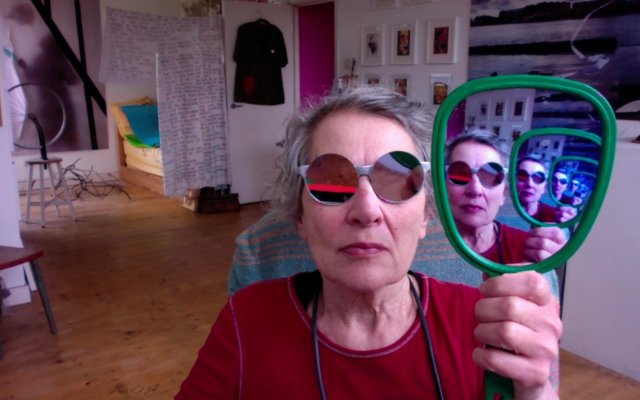
Anna Brass – “Haukebodde Hacoud Hacwod Aukud”
Anna Brass is an artist and filmmaker based in Norwich. Set in late medieval Italy and Essex, Brass’ short film explores earthly bodies and celestial realms. Brass draws on a diverse imagery to depict a world populated with strange objects: an oversized pilgrim badge, talking maiolica pots, and a dazzle camouflaged cathedral. Shot on 16mm with a cast of non-actors, the film presents a rich series of tableaux dense with the artist’s sculptures, backdrops and makeshift constructions. ‘Haukebodde Hacoud Hacwod Aukud’ is supported by Stuart Croft Foundation.
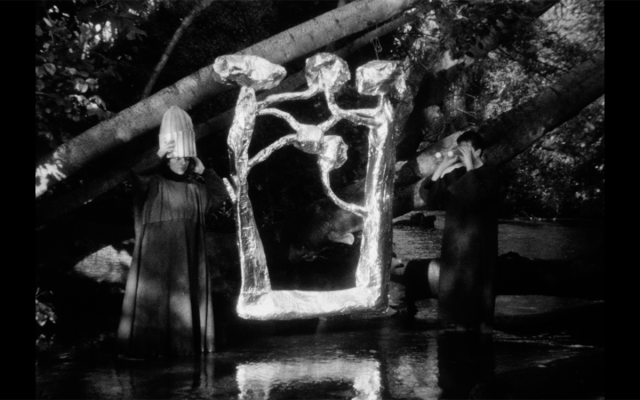
Ansuman Biswas - “Before, During, After"
Ansuman Biswas works in a wide variety of media, but his central concern lies between science, work and religion. He is interested in traversing, transposing and translating across many different kinds of border.
To paraphrase the 13th Century Zen philosopher Dōgen: “Before my search mountains are mountains and streams are streams. During my search mountains are no longer mountains and streams are no longer streams. After my search mountains are mountains and streams are streams.”
Biswas’ performance “Before, During, After” reflects on Spiritual Materialism within practices of pilgrimage and on the search for the miraculous as a kind of yearning for something out of the ordinary, something more than mundane.
“They do come to you, but you do not hear them. You have not sat in the field in the evening listening for them. When the angelus rings, you cross yourself and have done with it. But if you prayed from your heart and listened to the thrilling of the bells in the air after they stopped ringing, you would hear the voices as well as I do.” George Bernard Shaw, Saint Joan (1923)
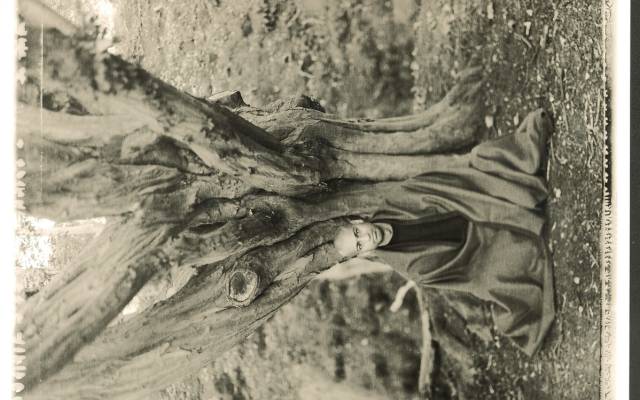
selina bonelli – “covered, dys-covered, re-covered :: a process of gaps and revelations”
selina is currently exploring abandoned post-conflict architecture through performance and sound. they hope to develop an affective trail of embodied witnessing of marginalized voices through the borders drawn into the landscape around these structures. they seek to explore the spaces outside of language by expanding on a listening through what touch could be to uncover the resonances trapped in ruins, utterances and hauntings.
“i will not have the words for a type of loss that is so distant it is intimate.” ALOK, funeral in Femme in Public (2017)
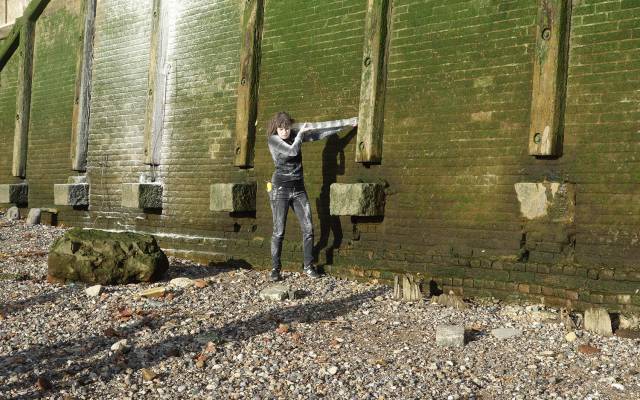
Oona Grimes – “Wool and Water”
Oona Grimes is a London based artist, primarily a chaser of language through drawing, clay making & film. During Grimes’ 2018 Bridget Riley Fellowship at The British School at Rome she segued from thieving Lorenzetti tartans and cartoon detail from Etruscan paintings, to the appropriation of neorealist films – mis-remembered, imitated and low tech re- enacted: a physical drawing of herself captured on i-phone.
Grimes’ interest in the The Miraculous stems from a love of medieval manuscripts and early Italian votives, depicting the supranatural in the everyday.
“Wool & Water” is a Norfolk Miracle which introduces Lewis Carroll to Pasolini. The Sheep (a metamorphoses of the White Queen from ‘Through the Looking Glass’) undertakes a quest for transformation and is finally granted sainthood.
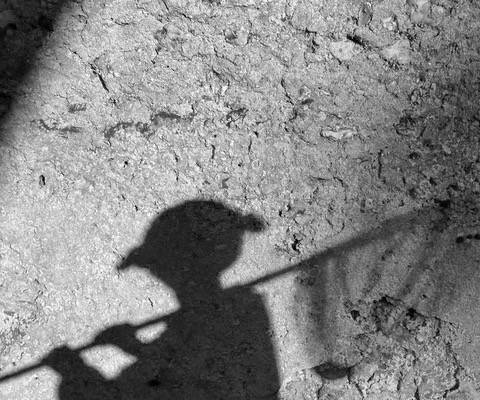
Poppy Jackson – “Holy Mile”
Based in Norfolk, Poppy Jackson views performance as a potential entranceway to the transformative, divine, or miraculous. Through use of creative intent in sacred site, the artist works with ritual action, charged material, duration as a means towards altered states of consciousness, and pilgrims, artists and audience as witness and collective energy.
The native ladybirds of this performance have been raised by the artist from young larvae. In becoming an abject female body through their interaction today; the work addresses Christianity’s complex views of, discomfort at, and influence upon the mother’s body. These are exemplified by the paradoxical figure of The Virgin Mary – a traditional mother figure sinless of sexual experience.
Ladybirds were named after the Virgin Mary in Medieval times when farmers prayed to Her to save their failing crops and ladybirds miraculously saved the fields from pests. In early religious paintings, Mary was often shown wearing a red cloak; the spots of the seven spot ladybird were said to symbolise Her seven joys and seven sorrows. Worldwide, cultures attribute ladybirds with luck, connection to the divine, protection of faith, and as a bringer of gifts, messages or even children (being called ‘little midwife’ (commaruccia) in some regions of Italy). In Christianity they are symbolic of the soul of Our Lady, standing for the Virgin Mary’s selfless compassion and sacrifice, and act as a mediator between earth and heaven, carrying prayers to the skies.
This mother’s body, barefoot along the ‘flight path’ of the Pilgrims Way, presents to us ladybirds’ cultural stand as a visual totem for the efficacy of prayer and connection to larger forces. ‘Holy Mile’ is inspired by the performativity of intent of the walkers of this ancient path at the site of a Mother Mary Miracle, whose footsteps span centuries of searching for the miraculous.
Joan Key – 16 Small Shrines
At first there was an interest in exploring the colours of red paint. This produced an association with Pompeian painting in which figures, now on the verge of ruin, can hold a cool presence, both mythic and fragile. That fleeting sensation of figural movement was more important than narrative recognition. It belongs to deep roots: what Abe Warburg refers to as ‘the fossil impressions of ancient energies’.*
In the studio, the cardboard shrines emerged during lockdown, which created enormous amounts of packaging for dispatch. Card was folded to protect contents, but once un-folded its shape was reminiscent of icons or altar pieces and their protective apotraic usage. The red is a Cadmium Burgundy, an expensive colour which, in association with Golden Ochre, holds associations with value. The thin watercolour paint surface suggested the opposite: povera, associated with the cardboard’s loss of contents and destroyed forms.
The miraculous potential of the shrine’s iconic usage can be productive in the understanding of narratives: secular or sacred. The association with prayer and rituals that protect or bring hope, health and prosperity, may be magnificent but similar qualities may also be found in the road-side shrines or votive offerings to household shrines for small.
There is a memory attached to making these works, of visiting a tiny Orthodox church in a remote Greek village. The iconostasis contained icons of various styles and dates, but there were many humble additions of printed cardboard icons, some quite modern, some dating from the nineteenth century. These could be faded or damaged by dust and damp, but nevertheless their sense of worth, as signs of attachment, remained. Permitted to have a place, humble images elevated by their setting and the hope they might literally bless, cure or remember their patrons, and those who worshipped in this remote place.
*Georges Didi-Huberman, ‘The Surviving Image, Phantoms of Time and Time of Phantoms, trans. Harvey Mendelsohn, Pennsylvania State University Press, 2017, p.218
Scilla Landale
Scilla Landale started guided running guided tours of Walsingham over 35 years ago. Scilla will offer a special presentation entitled “The The Miraculous Story of Walsingham Seen Through Glass”. This talk will contextualise “In Search of the Miraculous” within the broader religious and historical context of Walsingham. Additionally, Scilla’s tours of Walsingham may be joined on Friday 26th May. (see above for details).
Reverend Gyoro Nagase
Reverend Gyoro Nagase first arrived in England in 1978 from Aichi prefecture, near Nagoya, in Japan, to assist in the construction of the first Peace Pagoda in the UK in Milton Keynes. In 1984 he moved to London, to construct the Peace Pagoda in Battersea park, which was completed the following year. Reverend Nagase makes pilgrimages to and from areas of social and political significance to promote peace, with just a begging bowl and a walking drum. Pilgrimages have included Brantwood (John Ruskin’s home), Coniston, Cumbria to London Peace Pagoda, Battersea Park, from Vienna Peace Pagoda to Oświęcim, (Auschwitz), from Ukraine to Russia to visit and pray at Chernobyl, and walk from Kiev to Yasnaya Polyana (Leo Tolstoy’s home).
Holly Slingsby – “Messenger’s Lament”
Holly Slingsby is a visual artist working in performance, video and painting. She studied at the Ruskin School of Art, Oxford University; and the Slade School of Art, London. Her visual language reflects a fascination with iconographic traditions, drawing on Biblical imagery, mythologies, and contemporary culture. Much of her recent work seeks to convey the often unspoken experience of infertility.
Slingsby’s work has been shown at Turner Contemporary, Margate; Bòlit, Centre d'Art Contemporani, Girona; Tintype, London; DKUK, London; Matt’s Gallery; Spike Island; Modern Art Oxford; Freud Museum, London; CCC Barcelona; LABS Bologna; ICA, London; FEM Festival, Girona; Art Licks Weekend, London; and Barbican, London.
Candide Turner Bridger – “Talismans”
Candide Turner Bridger is an ecoartist and pigment maker, based in Walsingham. She works with the earth in site specific projects, using the soil to make rich and colourful pigments. Her work questions our relationship to nature by exploring symbols and patterns within.
Candide researches the history and folk tales from a site she has taken the soil to make pigment from and holds workshops where the audience are encouraged to create a dialogue around our history with nature, and the importance of ecological and social justice. Her aim is to inspire care and respect for the world we live in.
Ecoart is grounded in ecological ethics; it encompasses the physical, biological, cultural, political and historical aspects of ecosystems.
Richard Wilson RA – “Warship - Worship”
Richard Wilson’s interventions in architectural space draw heavily for their inspiration from the worlds of engineering and construction.
The ship (bark or barque, barchetta) was an ancient Christian symbol. It is the Church tossed on the sea of disbelief, worldliness, and persecution but finally reaching safe harbour with its cargo of human souls. “A ship carries the body and the church carries the soul”
It was also a great symbol during times when Christians needed to disguise the cross, since the ship’s mast forms a cross in many of its depictions.
The term nave is from navis, the Latin word for ship, an early Christian symbol of the Church as a whole, with a possible connection to the Ship of St. Peter or the Ark of Noah.
The term may also have been suggested by the keel shape of the vaulting of a church. In many Nordic and Baltic countries a model ship is commonly found hanging in the nave of a church, and in some languages the same word means both “nave” and “ship”.
Tickets: This is a non-ticketed event
‘In Search of the Miraculous’ is convened and curated by Anne Bean. The project is produced by FUTURE RITUAL, and funded and supported by Arts Council England, East Anglia Art Fund, Norfolk & Norwich Festival and Norfolk County Council.